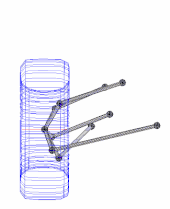Multi-link suspension
| Multi-link suspension |
|---|
A multi-link suspension is a type of vehicle suspension design typically used in independent suspensions, using three or more lateral arms, and one or more longitudinal arms. These arms do not have to be of equal length, and may be angled away from their 'obvious' direction.
Typically each arm has a spherical joint (ball joint) or rubber bushing at each end. Consequently they react loads along their own length, in tension and compression, but not in bending. Some multi-links do use a swing arm or wishbone, which has two bushings at one end.
On a front suspension one of the lateral arms is replaced by the tie-rod, which connects the rack or steering box to the wheel hub.
In order to simplify understanding it is usual to consider the function of the arms in each of three orthogonal planes.
Plan view
The arms have to control toe/steer and lateral compliance. This needs a pair of arms longitudinally separated.
Front view
The arms have to control camber, particularly the way that the camber changes as the wheel moves up (into jounce, or bump) and down into rebound or droop.
Side view
The arms have to react traction and braking loads, usually accomplished via a longitudinal link. They also have to control caster. Note that brake torques also have to be reacted - either by a second longitudinal link, or by rotating the hub, which forces the lateral arms out of plane, so allowing them to react 'spin' forces, or by rigidly fixing the longitudinal link to the hub.
Advantages of multi-link suspension
In its simplest form the multi-link suspension is orthogonal - that is, it is possible to alter one parameter in the suspension at a time, without affecting anything else.
This is in direct contrast to say a double wishbone suspension where moving a hardpoint or changing a bushing compliance will affect two or more parameters.
Advantages also extend to off road driving. A multi-link suspension will allow the vehicle to flex more, this means simply that the suspension will be able to move more easily to conform to the varying angles of off roading. This being said, multi-link equipped vehicles are ideally suited for sports such as rock crawling, and desert racing. A side note to the use of multi-link suspension use in desert racing, the use of a good sway bar is needed to counter body roll.
Disadvantages of multi-link suspension
It is very hard to optimise the geometry without a full 3d analysis, and compliance effects are important.

